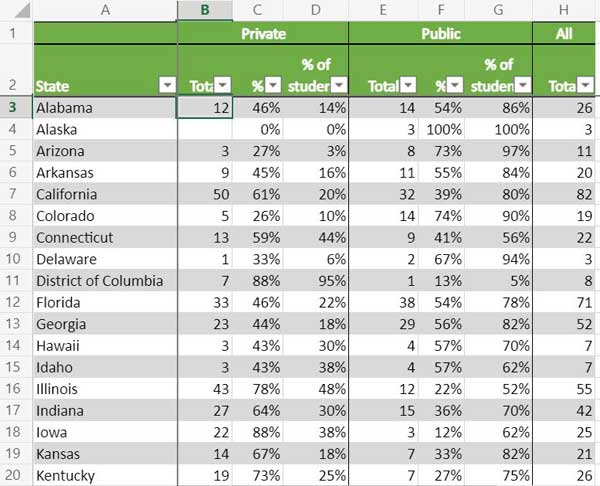 There are common stereotypes of public and private colleges. Public universities offer a much lower sticker price than private institutions while private colleges have the reputation of being small and personal but expensive. And while these perceptions contain some truth, you really shouldn’t let them limit your college search.
There are common stereotypes of public and private colleges. Public universities offer a much lower sticker price than private institutions while private colleges have the reputation of being small and personal but expensive. And while these perceptions contain some truth, you really shouldn’t let them limit your college search.
Let’s start with how much truth there is to these stereotypes. Of the 721 four-year colleges with 3,000 or less full-time students, 123 are public institutions. There are 13 states that don’t even have a public college with less than 3,000 students. It’s not surprising that US News College Rankings of the top 100 liberal arts colleges doesn’t include any public schools except for the military academies.
Smaller Doesn’t Guarantee Better
However, while those looking for a small size would seem to do better looking at private colleges, simply being private isn’t a guarantee of a quality education. Well over half of the almost 600 private colleges with less than 3,000 students have a four-year graduation rate of less than 50%. Of course, almost three-quarters of all public institutions of the same size also have graduation rates of less than 50%. The point is that private doesn’t automatically mean you’ll receive a better education.
Public Colleges Aren’t Always Cheaper
Now about the lower price advantage. If you go strictly be sticker price, public universities will be cheaper than private ones. Yet, few families actually pay the full cost of private institutions. Of the 424 schools that have an average net price of $10,000 or less for families with an income of $30,000 or less (yes, I know, not exactly a low bar), 61 of them are private institutions. If you look only at the 123 schools in the category that also have at least as 50% graduation rate (four-year rate for private schools, five-year rate for public), 43 are private schools.
In general, there really isn’t any reason to search for schools solely by their “public” or “private” status as long as you’re only considering your “in-state public” institutions. If you have in-state options, paying out-of-state tuition for a public university is a generally a bad idea.
Most Students Attend Public Colleges
While the number of private colleges outnumber to public universities, nationally, about only three out of ten full-time students attend a private four-year institution. In only four states, Massachusetts, Rhode Island, New Hampshire, and New York, and the District of Columbia, do more than half of full-time students attend private colleges.
Private Colleges Outnumber Public Colleges
Even though the majority of students attend public institutions, private colleges are in the majority in 28 states. This is because private colleges average 2,358 full-time undergraduates while public institutions average 7,899 students.
Of the remaining 33 states, three, New Mexico, Alaska, and Wyoming do not have any private colleges with 500 or more full-time students. Nevada, Arizona, North Dakota, West Virginia, Mississippi, and Colorado all had 10% or fewer students attending private schools.
Clearly, where you live will affect the number of schools available. The financial penalty of attending out-of-state public schools means that they will be the most limited option for most students. While students will have to take into account travel cost when considering out-of-state private colleges, there are a lot more options available among private colleges. A good college list can include both public and private as long as they meet your family’s academic and financial needs.
Public and Private Colleges by State



1 thought on “Public Versus Private Colleges: Does it matter?”